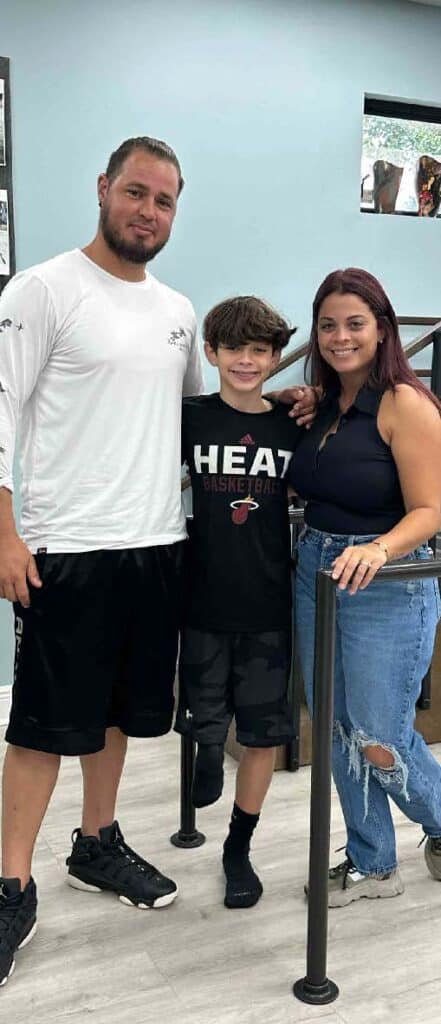Life Will Not Go the Way You Want
By Ed Mahoney
Photography by Tina Mahoney
Prosthetist, patients keep dreams moving forward
 I went to the office of Palm Beach Prosthetics and immediately was greeted by Matt Bailey. Matt has been the owner and operator of the facility since 1997. His company is part of Florida O&P Services Inc. Matt constantly assists patients who need exceptional care and can’t afford expensive options. “I think life should be about making an effort to give other people support,” Matt said.
I went to the office of Palm Beach Prosthetics and immediately was greeted by Matt Bailey. Matt has been the owner and operator of the facility since 1997. His company is part of Florida O&P Services Inc. Matt constantly assists patients who need exceptional care and can’t afford expensive options. “I think life should be about making an effort to give other people support,” Matt said.
An entrance room has a counter full of coffee apparatus to assist in keeping him awake during long hours and for patients who need it. A middle room has all the physiotherapy devices to help patients train themselves, especially with new protheses.
Several other rooms hold equipment where the prosthesis construction work is done. Matt and two co-workers engage in the process.
The patient must be ready for the physical part of using the new limb. If a limb is initially being attached to artificial parts, this will require a therapist to work directly with the patient. The therapist helps to get patients ready not only to walk but to move in the way they did before they needed the prosthesis. Some patients have remarkable success with the new limbs and can eventually run after the rehabilitation process.
The way Matt generally operates is to make the basic leg. He buys from developers mechanical parts such as knees, ankles and feet. But he can and does create such parts when custom care is needed.
Matt is currently specializing in rotationplasty. This occurs when cancer creates a tumor on an upper leg. It requires an amputation of the upper leg and knee, and the surgeon raises the bottom part of the leg and rotates the foot to point backward. The device that Matt has helped develop allows the foot to function as a knee.
I met three patients in Matt’s office that afternoon. The first was an older woman who was there with her husband getting her prosthesis repaired. The most amazing fact about the woman was that she has used the prosthesis for over 80 years. She seemed perfectly in tune with the device and, when the new one came out of the backroom fixed, she placed it on her limb and walked with it. She felt exhilarated. It was like buying new shoes. She was ready to go on with her life.
 The second patient was a young girl from Haiti, named Miradaline, who lived in an orphanage. She was born with both legs mutated. Matt sat down with her immediately and asked to have her take the devices off and then the socks. Miradaline only speaks Creole, so they had to get a person on the phone from the orphanage. Matt looked at the velcrosocks and determined there was a problem that was causing them to build lumps in the tissue. He told the two companions and the person on the phone that these socks should never be washed with any kind of soap or detergent other than hand lotion, something light.
The second patient was a young girl from Haiti, named Miradaline, who lived in an orphanage. She was born with both legs mutated. Matt sat down with her immediately and asked to have her take the devices off and then the socks. Miradaline only speaks Creole, so they had to get a person on the phone from the orphanage. Matt looked at the velcrosocks and determined there was a problem that was causing them to build lumps in the tissue. He told the two companions and the person on the phone that these socks should never be washed with any kind of soap or detergent other than hand lotion, something light.
The woman on the phone told them Miradaline was playing soccer and getting sand in her devices. She washed them every two days but was using detergent. Miradaline just sat there while this was all going on smiling so brightly. Her visit ended with Matt giving her new socks.

The final patient was a 10-year-old girl named McKenzie. Her mother, Tracy, told me McKenzie had lost her foot and part of her leg at the age of 4. Her father had been mowing a large patch of lawn at their house, and McKenzie ran out to talk to him. She slipped, and her leg went under the mower. She needed a special surgeon to execute the proper operation on the leg. The family’s insurance didn’t cover the surgeon. They received help from an organization in Orlando called Rebecca’s Angels. Eventually, they were introduced to Matt. When he got McKenzie properly aligned with the prosthesis, she accepted it right away and taught herself to walk. She is currently doing anything a 10-year-old would normally do.
 Tracy was pregnant when it happened and had a baby boy 31 days after the accident. She told me she had terrible mental and emotional issues because she felt responsible. She assumed McKenzie’s life was damaged and would never be the same. Her husband was impacted also but wouldn’t talk about it.
Tracy was pregnant when it happened and had a baby boy 31 days after the accident. She told me she had terrible mental and emotional issues because she felt responsible. She assumed McKenzie’s life was damaged and would never be the same. Her husband was impacted also but wouldn’t talk about it.
Much time of suffering included days when Tracy didn’t want to get out of the bed. Suicide floated in her head. But she fought it. She got psychiatric help. “I went to an art instructor. The art therapy was wonderful.” She was determined to stay with the family, her husband and her three children. Every day she fights the negativity, but she stands tall over it. And, the amazing thing is, McKenzie has given her the love and support she needed to overcome the problem. Tracy said about Matt and his group, “We feel like family.”
Tracy further stated, “Life is not what you want it to be.” All of us must deal with the problems that come along and stand up no matter what they are. We all need help from others. This is what we should be living for.

